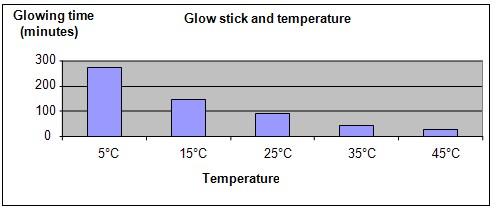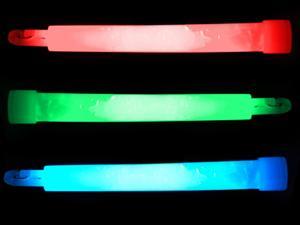| Complexity level: | 4 |
| Project cost ($): | 30 |
| Time required: | 1 hour to prepare, 2 hours for observation |
| Material availability: | Easily found |
| Safety concerns: | None |
Hypothesis
The light from a glow stick will extinguish more quickly at higher temperatures.
Overview
Glow stick
Glow sticks are plastic tubes containing chemicals that produce a temporary glow of light when they are mixed together. This process is called chemiluminescence, where light is produced by a chemical reaction without an electrical source.
The chemicals used in the glow stick consist of a fluorescent dye with diphenyl oxalate and hydrogen peroxide. Mixing the chemicals causes a reaction which produces peroxyacid ester and phenol. The decomposition of the peroxyacid ester into carbon dioxide releases energy that excites the atoms in the fluorescent dye, causing it to release particles of light called photons.
Glow sticks are constructed of 2 internal containers which separate the chemicals. A small and fragile container is encased in a larger and more flexible outer container. When the plastic stick is bent, the fragile wall of the smaller container breaks and the 2 chemicals mix, producing light which makes the stick glow.
Glow sticks are popularly used during parties, night parades, concerts and festivals. Glow sticks are also useful in places that do not have a power source and they are regularly used by campers, divers and military personal. Another application for glow sticks is in places that have been struck by disasters like tsunamis, earthquakes or tornadoes. These places pose the danger of gas leaks and since glow sticks do not produce sparks, they are safe to use in such situations.
Scientific Terms
Materials
The materials required for this science fair project:
- 5 beakers
- 1500ml distilled water
- A measurement cylinder
- 25 glow sticks
- A stopwatch
- 2 hot plates
- 5 thermometers
- A bag of ice
Procedure
1. For this science fair project, the independent variable is the temperature of the water in the beaker, i.e. 5°C, 15°C, 25°C, 35°C and 45°C. The dependent variable is the average length of time the sticks will glow. This is determined by using a stopwatch to measure the time. The constants (control variables) are the size of the beaker, amount of water in the beaker and type of glow stick used.
2. The 5 beakers are labeled “5°C”, “15°C”, “25°C”, “35°C” and “45°C”. Using a measuring cylinder, 300ml of distilled water is poured into each beaker. A thermometer is placed in each beaker.
3. The required amount of ice is added into the 1st and 2nd beakers to maintain their temperatures at 5°C and 15°C. The temperature of the 3rd beaker will be maintained at 25°C, i.e. room temperature. The 4th and 5th beaker are placed on hot plates and the temperatures of the water in the beakers are brought to 35°C and 45°C.
4. The 25 glow sticks are snapped and 5 of them are placed in each beaker. The stopwatch is started and the lights in the room are switched off or curtains are drawn to reduce room light. The time taken for the light in the glow sticks to be extinguished is observed. The average time taken for the 5 sticks in each beaker to stop glowing is recorded and the results are shown in the table below.

Results
It is observed that the glow sticks in the warmer waters glowed brighter but they also extinguished the fastest. The glow sticks in cold water were dimmer but continued to produce light the longest.
| Water temperature | 5°C | 15°C | 25°C | 35°C | 45°C |
| Glow time (minutes) | 274 | 147 | 93 | 41 | 27 |
The graph below represents the results of our science project experiment:

Conclusion
The hypothesis that light from a glow stick will extinguish faster at higher temperatures is correct.
Glow sticks are very popular with children at all sorts of festive events and parties. Spectators carry them duringparades to add to the festive atmosphere. However, the plastic tubes/containers need to be disposed properly after use because the chemicals within the glow sticks are toxic. Contact with skin must be avoided.
Also consider
Try to repeat the science fair project using different colored glow sticks and compare their glow time.
The experiment can also be done to compare results produced by different sized and shapes of glow sticks.
References
Glow stick - http://en.wikipedia.org/wiki/Glow_stick
How light sticks work - http://science.howstuffworks.com/light-stick.htm
"
Glow in the dark mountain dew - http://chemistry.about.com/b/2008/03/03/glow-in-the-dark-mountain-dew-2.htm

